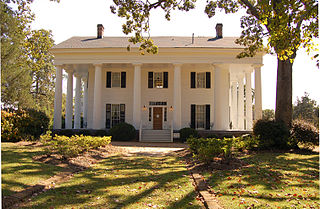
Columbia is a city in and the county seat of Maury County, Tennessee, United States. The population was 34,681 at the 2010 census and in 2019 the population was 40,335. Columbia is included in the Nashville metropolitan area.

The Hermitage is a historical plantation and museum located in Davidson County, Tennessee, United States, 10 miles (16 km) east of downtown Nashville. The plantation, a forced-labor farm worked by enslaved black people, was owned by Andrew Jackson, the seventh President of the United States, from 1804 until his death at the Hermitage in 1845. Jackson only lived at the property occasionally until he retired from public life in 1837. It is a National Historic Landmark.

Fort Pillow State Historic Park is a state park in western Tennessee that preserves the American Civil War site of the Battle of Fort Pillow. The 1,642 acre (6.6 km²) Fort Pillow, located in Lauderdale County on the Chickasaw Bluffs overlooking the Mississippi River, is rich in both historic and archaeological significance. In 1861, the Confederate army built extensive fortifications and named the site for General Gideon Johnson Pillow of Maury County. It was attacked and held by the Union Army for most of the American Civil War period except immediately after the Battle of Fort Pillow, when it was retaken by the Confederate Army. Many African-American soldiers were killed in what modern historians describe as a "massacre" or "atrocity". Interpretive sites are part of the park.

The Victorian Village District is an area of Memphis, Tennessee.

The Athenaeum Rectory is a historic building in Columbia, Tennessee that features both Gothic and Moorish architectural elements. Completed in 1837, the building originally served as the rectory for the Columbia Female Institute and as the residence of the school's first president, the Reverend Franklin Gillette Smith. The structure was added to the National Register of Historic Places in 1973.

Rattle and Snap is a plantation estate at 1522 North Main Street in Mount Pleasant, Tennessee. The centerpiece of the estate is a mid-1840s mansion that is one of grandest expressions of the Greek Revival in Tennessee. It was designated a National Historic Landmark in 1971 for its architecture, and for its association with the Polk family, once one of eastern Tennessee's largest landowners. The house is privately owned, but may be viewed by appointment.

St. John's Episcopal Church is a historic Episcopal church in Ashwood, Maury County, Tennessee, United States. Built from 1839 to 1842 by Bishop Leonidas Polk, it was an active church in the Antebellum South. It was ransacked and later used as a hospital for the Confederate States Army during the American Civil War of 1861-1865. Services resumed after the war, but they were discontinued due to low attendance in 1915. It is now closed, except for an annual pilgrimage.

Franklin Battlefield was the site of the Second Battle of Franklin, which occurred late in the American Civil War. It is located in the southern part of Franklin, Tennessee, on U.S. 31. It was declared a National Historic Landmark in 1960.

Antebellum architecture is the neoclassical architectural style characteristic of the 19th-century Southern United States, especially the Deep South, from after the birth of the United States with the American Revolution, to the start of the American Civil War. Antebellum architecture is especially characterized by Georgian, Neo-classical, and Greek Revival style homes and mansions. These elegant mansions were built in the southern American states during roughly the thirty years before the American Civil War; approximately between the 1830s to 1860s.
Nathan Vaught was a builder in Tennessee who was responsible for several noteworthy buildings.

Hamilton Place is an antebellum plantation house in Maury County, Tennessee, near Columbia.

West Meade is a historic mansion in Nashville, Tennessee, United States.

Cleveland Hall is an Antebellum mansion in Nashville, Tennessee.

The Deery Inn, also known as "The Old Tavern" or "The Mansion House and Store," is a historic building on Main Street in Blountville, Tennessee. It is listed on the National Register of Historic Places and is considered the "centerpiece" of the Blountville local historic district.

Pillow-Bethel House is an historic mansion located off U.S. Route 43 in the city of Columbia, Maury County, Tennessee, United States. The mansion is one of three, built by master builder Nathan Vaught in 1855, for Jerome and Martha Harris Pillow. The other two were Clifton Place and Pillow Place, also known as Pillow-Haliday Place.

Clifton Place is an historic plantation mansion located southwest of the city of Columbia, Maury County, Tennessee on the Mt. Pleasant Pike. Master builder Nathan Vaught started construction in 1838, and the mansion and other buildings were completed in 1839, for Gideon Johnson Pillow (1806-1877) on land inherited from Gideon Pillow.

Ashwood is an unincorporated community in Maury County, Tennessee, in the United States.

Walnut Grove is a historic house on a Southern plantation in Mount Pleasant, Maury County, Tennessee, USA.

Skipwith Hall, also known as Oakwood Farm, is a historic mansion in Maury County, Tennessee, USA.

For the Beaver Dam Plantation in North Carolina, see Beaver Dam Plantation House.
















